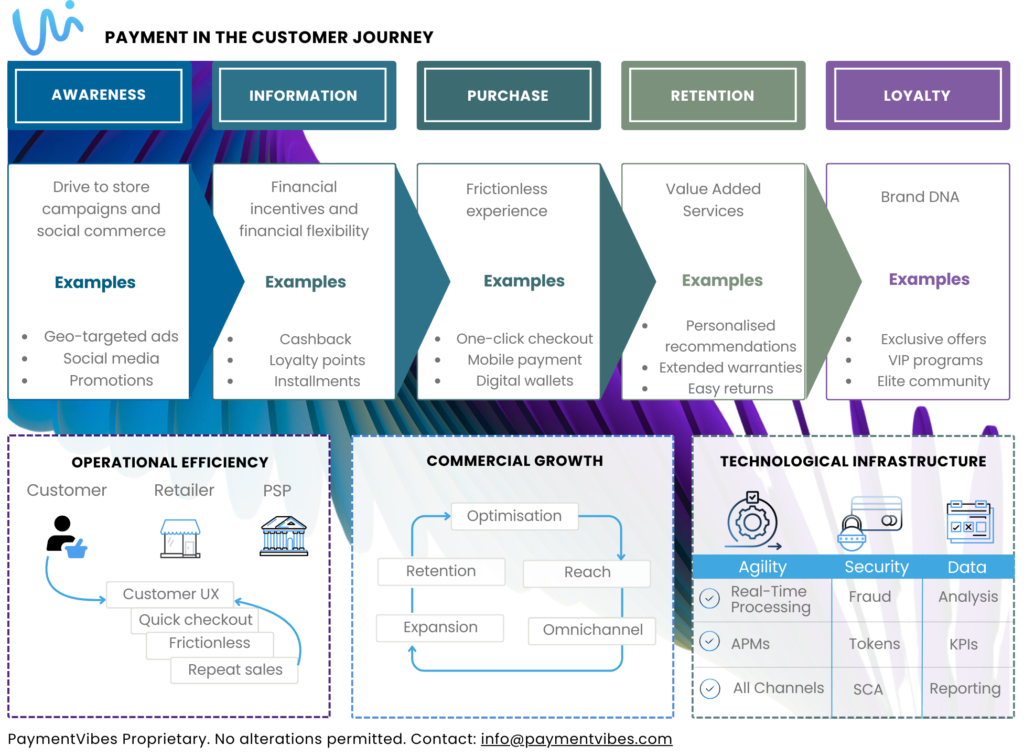The foundational state of omnichannel retailing
Winning in an omnichannel world demands excelling in all channels, from in-person to hybrid, inside sales, digital self-serve, and marketplaces. According to McKinsey the average shopper now interacts with retailers through multiple touchpoints before making a purchase decision. This number has doubled from five touchpoints just a few years ago, indicating the growing complexity of the customer journey.
The success of an omnichannel strategy hinges on efficient service offerings and meticulous stock management to ensure product availability across all channels. However, what appears seamless on the front end necessitates a coherent and connected approach on the back-end. A critical component of a well-executed omnichannel strategy involves the integration of payment systems, to ensure that shoppers can easily complete transactions regardless of the channel they choose. Just as customers view shopping through a unified lens, they expect to have seamless experience, where the intricacies of payment are invisible to them. In this context, the payment data are key and need to be leveraged at every product touchpoint to enable a 360-degree customer view. This providing insights into customer preferences, behaviours, and purchasing patterns. This can be reflected through:
- Seamlessly transition payments across channels: Today’s shopper want to start a payment on one platform (e.g., mobile) and complete it on another (e.g., desktop or in-store) without necessarily re-entering payment information.
- Access to their preferred payment methods: Whether they are shopping online, using a mobile app, or in a physical store, customers expect to use their preferred payment methods (e.g., digital wallets, credit cards, BNPL) consistently across all channels.
- Robust payment security: Shoppers demand consistent security measures and fraud protection across all payment channels regardless of how and where they shop.
These expectations highlight that the customer journey is now dynamic, accessible, and continuous, requiring retailers to adapt quickly to meet evolving consumer expectations, whilst building customer trust.
This approach extends to payment systems, which play a crucial role in the overall customer experience. It requires the seamless integration of multiple systems capable of tracking stock levels in real-time and optimizing distribution to prevent stockouts or overstocking whilst handling large volumes of data from various sources. Coordination among these systems is critical to ensure they work together harmoniously to create a robust omnichannel infrastructure that can support a retailer’s strategic goals and deliver an exceptional customer experience. Equally important is the integration of a unified payment gateway that supports multiple payment options, ensuring a consistent and secure payment process across all channels.
Frictionless Shopping: Why a Seamless Payment Experience Matters

Payments have grown to become foundational elements of a successful omnichannel retailing strategy in this respect. Consumers do reward a connected journey, one that is seamless regardless of where and how they pay.
As a former Head of Payments in a leading luxury group, I have seen firsthand the strategic importance of robust payment systems in the retail industry. Payment systems are not merely transactional tools, they are integral to enhancing the overall customer experience and driving business growth. A well-integrated payment system significantly improves a retailer’s operations, enhances the customer experience, and drives business growth through increased efficiency, security, and customer loyalty. Effective data management and optimal vendor relationships are also crucial aspects of an effective payment strategy.
However, quite often payment systems can be underestimated, as many retailers tend to focus more on visible aspects of their operations. Understandably so, as the complexity and sometimes cost implication of managing those systems can be deterring if they don’t align well with other business priorities and investments.
From a retailer’s perspective, payment services intersect with three main pillars: Operational Efficiency, Commercial Growth, and Technological Infrastructure.
Operational Efficiency
A seamless payment process can significantly:
- Enhance the customer experience
- Reducing friction at the point of sale, whether online or in-store.
- Enable quicker checkouts, minimising wait times and improving overall customer satisfaction
- Drive customer engagement and repeat purchases, when integrating payment services with loyalty programs and personalised offers
Moreover, the ability to analyse payment data can provide valuable insights into customer behaviour and preferences. By leveraging these data, retailers can optimise their pricing strategies, tailor marketing efforts, and improve inventory management.
A consistent and secure personalized checkout experience, paired with flexible payment options and omnichannel return and refund policies, contributes to a seamless customer journey, ultimately driving satisfaction and loyalty. According to a report by Klarna, 25% of US shoppers value a personalized checkout experience, based on a brand knowing their previous payment preferences.
Commercial Growth
A well-executed payment strategy drives commercial growth by supporting both expansion and cost optimisation. This includes the ability for the retailers to reach new customer segments and retain existing ones through seamless payment experiences by integrating with various sales channels and supporting multiple payment methods and currencies. For example, understanding which payment methods are most popular can help retailers streamline their payment processing systems and reduce associated costs. According to American Express, 85% of online shoppers would abandon a payment if unable to use their preferred method.
Technological Infrastructure
The technological infrastructure supporting payment services must be agile, secure, and capable of passing relevant data across the multiple systems retailers operate from. This includes data processing, customer data, supplier data.
Security has become a critical aspect of payment services. With the increasing prevalence of online shopping, the risk of fraud has also risen. There are a lot of innovation, driving robust security measures, such as encryption and tokenization, to protect customer data and ensure secure transactions. These, as dry as they may sound, are essential consideration to blend in with the payment strategy.
An example of a distinct use case is the Amazon One-Click Checkout feature, which reduces checkout friction, significantly lowering cart abandonment rates. Another example is Apple Pay, which facilitates secure, contactless payments both online and in-store. According to a report by Loup Ventures, Apple Pay adoption by banks and top retailers increased by over 20% across desktop sites, mobile web, and apps. This significant growth indicates that Apple Pay is becoming an essential payment option for retailers and banks.
Unlocking Competitive Advantage through Data
Transitioning to an omnichannel environment is not just a trend but a necessity for modern retailers aiming to remain competitive.
Retailers have always needed to put the customer at the center of their thinking and operational models. Now, with the advent of real-time insights from multiple purchasing data streams, executing on those insights separate the winners from the crowd. Today shoppers have countless choices at their fingertips, understanding and connecting with these varied group has become more crucial than ever. Fortunately, we are equally living in a world where data and technology solutions can empower retailers to enhance customer engagement.
One of the key considerations for retailers in that respect when creating an omnichannel strategy is whether to work from one payment provider or multiple providers. Finding a balance between these two directions is a key factor in deciding on an optimal strategy.
How can we help?
At PaymentVibes, we bridge the gap between business strategy and execution for retail merchants by enhancing payment capabilities, enabling faster achievement of business objectives. Our unique blend of retail experience and deep payment industry knowledge allows us to elevate your payment organization and tailor our expertise to your business needs.
Contact us for a discovery discussion.

